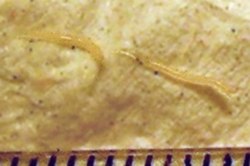Types
Viral
Pathogenic viruses are mainly those of the families of: Adenoviridae, Picornaviridae, Herpesviridae, Hepadnaviridae, Coronaviridae, Flaviviridae, Retroviridae, Orthomyxoviridae, Paramyxoviridae, Papovaviridae, Polyomavirus, Poxviridae, Rhabdoviridae , and Togaviridae . Some notable pathogenic viruses cause smallpox, influenza, mumps, measles, chickenpox, ebola, and rubella. Viruses typically range between 20 and 300 nanometers in length. [1]
This type of pathogen is not cellular; instead a protein shell (the capsid) encases either RNA (Ribonucleic acid) or DNA (Deoxyribonucleic acid). Pathogenic viruses infiltrate host cells and manipulate the organelles within the cell such as the Ribosomes, Golgi Apparatus, and Endoplasmic Reticulum in order to multiply which commonly results in the death of the host cell via cellular decay. All the viruses that were contained within the lipid bilayer of the cell membrane are then released into the intercellular matrix to infect neighboring cells to continue the viral life cycle.
White blood cells surround and consume the virus using a mechanism known as phagocytosis [2] (a type of endocytosis) [3] within the extracellular matrix to reduce and fight the infection. The components within the white blood cell are responsible for destroying the virus and recycling its components for the body to use. [4]
Bacterial

Although the vast majority of bacteria are harmless or beneficial to one's body, a few pathogenic bacteria can cause infectious diseases. The most common bacterial disease is tuberculosis, caused by the bacterium Mycobacterium tuberculosis , which affects about 2 million people mostly in sub-Saharan Africa. Pathogenic bacteria contribute to other globally important diseases, such as pneumonia, which can be caused by bacteria such as Streptococcus and Pseudomonas , and foodborne illnesses, which can be caused by bacteria such as Shigella , Campylobacter , and Salmonella . Pathogenic bacteria also cause infections such as tetanus, typhoid fever, diphtheria, syphilis, and Hansen's disease. They typically range between 1 and 5 micrometers in length. [5]
Fungal
Fungi are a eukaryotic kingdom of microbes that are usually saprophytes, but can cause diseases in humans. Life-threatening fungal infections in humans most often occur in immunocompromised patients or vulnerable people with a weakened immune system, although fungi are common problems in the immunocompetent population as the causative agents of skin, nail, or yeast infections. Most antibiotics that function on bacterial pathogens cannot be used to treat fungal infections because fungi and their hosts both have eukaryotic cells. Most clinical fungicides belong to the azole group. The typical fungal spore size is 1-40 micrometers in length. [6]
Other parasites
Protozoans are single-celled eukaryotes that feed on microorganisms and organic tissues. Considered as "one-celled animal" as they have animal like behaviors such as motility, predation, and a lack of a cell wall. Many protozoan pathogens are considered human parasites as they cause a variety of diseases such as: malaria, amoebiasis, babesiosis, giardiasis, toxoplasmosis, cryptosporidiosis, trichomoniasis, Chagas disease, leishmaniasis, African trypanosomiasis (sleeping sickness), Acanthamoeba keratitis, and primary amoebic meningoencephalitis (naegleriasis).

Parasitic worms (Helminths) are macroparasites that can be seen by the naked eye. Worms live and feed in their living host, receiving nourishment and shelter while affecting the host's way of digesting nutrients. They also manipulate the host's immune system by secreting immunomodulatory products [7] which allows them to live in their host for years. Many parasitic worms are more commonly intestinal that are soil-transmitted and infect the digestive tract; other parasitic worms are found in the host's blood vessels. Parasitic worms living in the host can cause weakness and even lead to many diseases. Parasitic worms can cause many diseases to both humans and animals. Helminthiasis (worm infection), Ascariasis, and enterobiasis (pinworm infection) are few that are caused by various parasitic worms.[ citation needed ]
Prionic

Prions are misfolded proteins that are transmissible and can influence abnormal folding of normal proteins in the brain. They do not contain any DNA or RNA and cannot replicate other than to convert already existing normal proteins to the misfolded state. These abnormally folded proteins are found characteristically in many neurodegenerative diseases as they aggregate the central nervous system and create plaques that damages the tissue structure. This essentially creates "holes" in the tissue. It has been found that prions transmit three ways: obtained, familial, and sporadic. It has also been found that plants play the role of vector for prions. There are eight different diseases that affect mammals that are caused by prions such as scrapie, bovine spongiform encephalopathy (mad cow disease) and Feline spongiform encephalopathy (FSE). There are also ten diseases that affect humans such as, Creutzfeldt–Jakob disease (CJD). [8] and Fatal familial insomnia (FFI).
Animal pathogens
Animal pathogens are disease-causing agents of wild and domestic animal species, at times including humans. [9]